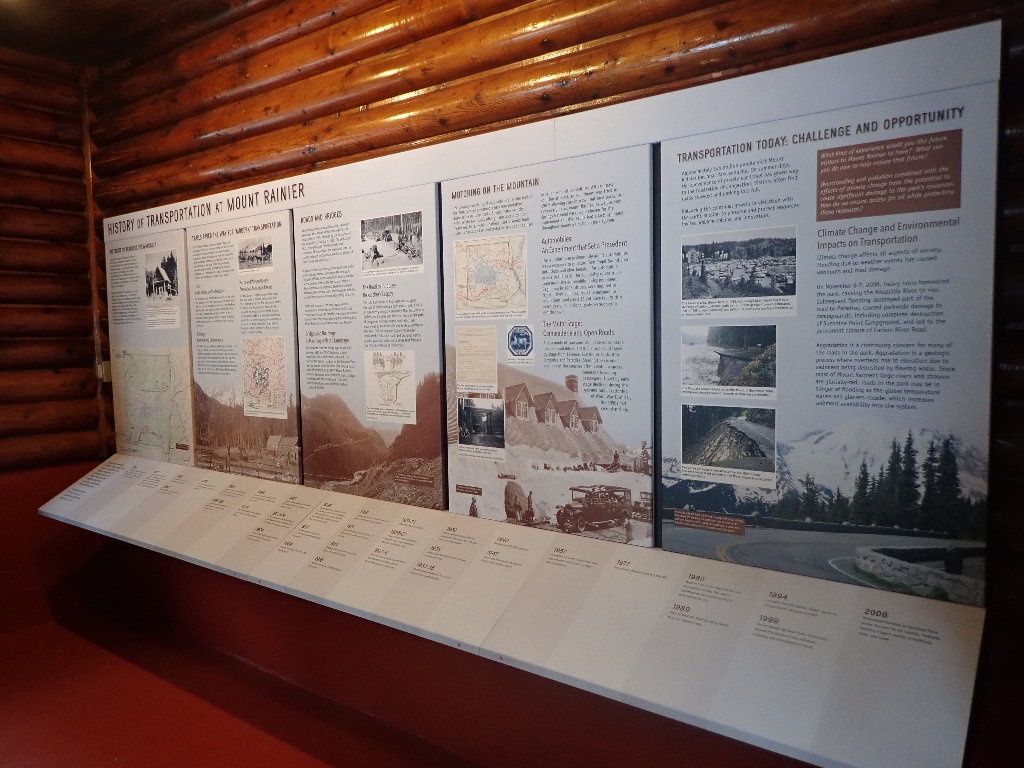
Season: Year-round
Longmire is located in the southwest corner of Mount Rainier National Park and is 6.5 miles (10.5 km) east of the Nisqually Entrance. The Transportation Exhibit is located inside the historic Longmire Service Station, which is next to the National Park Inn. The exhibit is open daily when the Longmire Museum is open. The exhibit panels are attached to the wall across from the door and consist of five panels with a timeline stretching across the bottom of the panels.
History of Transportation at Mount Rainier
Panel 4 Title: Motoring on the Mountain
Panel 4 Main Text
The growing popularity of automobiles after the turn of the 20th century presented a new transportation dilemma for national parks. Should motor vehicles, which might eventually offer greater access to more Americans, be allowed in national parks? Would their noise, exhaust, and unpredictable drivers spoil the park experience for other visitors? With no easy solution at hand, an experiment was tried in 1907: allowing cars into two national parks on a temporary basis. Mount Rainier, as well as Hot Springs National Park, were chosen for the experiment and the results had a lasting impact throughout America’s national park system.
Automobiles: An Experiment that Set a Precedent - The decision to experimentally admit automobiles was a response to pressure from Puget Sound area auto clubs and civic boosters for automobile access to the park. The popularity of car travel soon made the automobile policy permanent. Beginning in 1908, drivers were required to register their vehicles, read the automobile regulations, and pay a $5 entrance fee. Within seven years, all national parks were open to vehicle travel.
The Motor Stage: Camaraderie and Open Roads - A new mode of transportation, the motor stage became available in 1910. Visitors could travel by stage from Tacoma, Seattle, or Ashford to Longmire and Paradise. Sharing the crowded confines of the coaches often created a special camaraderie among passengers. Travel by auto stage declined during the gas and rubber rationing of World War II and by the 1950s had ceased entirely.
Panel 4 Description
The text fills the top two-thirds of the panel in two columns against a pale blue background. Towards the top of the left-side column is an image of a historic map of Mount Rainier National Park. The park border is highlighted in green with roads bolded in red. The roads include the road from Nisqually Entrance to Paradise and Westside Road in the southwest corner of the park, and the road to White River and Sunrise in the northeast corner of the park. Other routes and trails are marked with fainter red lines. A caption below the map reads “The regulations in this 1933 guide reminded motorists that, ‘Teams, saddle and pack animals, and ascending motor vehicles have the right-of-way.’” Below the map are two smaller images. A copy of a faded document on the left is captioned “The first automobile permit was issued in Mount Rainier National Park in 1908.” On the right is faded blue image of a deer in front of a mountain within a border shaped like an octagon. Stylized text on the image reads “Mt Rainier National Park 1939.” A caption reads “A Mount Rainier vehicle pass for the 1939 season". At the bottom of the right-side column is black and white photo of a vehicle passing under a large log archway on a muddy road. The “archway” consists of three large logs supported by a frame of large logs. A caption under the photo reads “Visitors have long been greeted by various entrance arches throughout the park.” The bottom third of the panel is filled with a historic sepia-toned photo that fades into the blue background of the rest of the panel at the top. The photo shows the angled shingle roof of the Paradise Inn, the bottom story hidden by a large snowbank with a tunnel cut into the snow to reach the entrance. On top of the snowbank next to the entrance is posed a dog sled with a team of dogs, while an old-fashioned black bus is parked in front of the inn. The photo is captioned “Concessionaire buses at the Paradise Inn, late 1920s”.
Panel 1: The Route to Resource Stewardship
Panel 2: Trails Paved the Way for “Modern” Transportation
Panel 3: Roads and Bridges
Panel 5: Transportation Today: Challenge and Opportunity
Transportation Timeline
Is there something we missed for this itinerary?
Itineraries across USA


















































